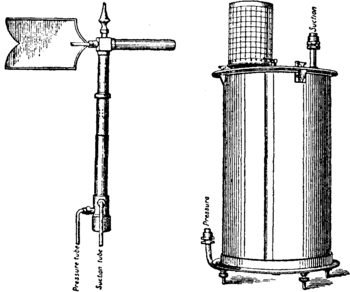Anemometer
The Dines anemometer sits in the weather cabin, atop the roof of the observatory. This instrument measured wind speed, direction and force of gusts. It is now defunct in its original use, however can be interpolated into experiments that focus on wind / sound / data collection and interpretation / othering perceptions of more-than-human nature, to name only a few.
The anemometer consists of a weather vane, tubes, rods and a tank with water and a float inside. The intra-active, expanded anemometer consists of all those parts, +:
- the material of the building and weather cabin, +
- architecture, decisions made to height and stability, +
- human attendance/labour to change the recording surface and wind the clock, +
- fluctuations in weather patterns over the peninsula, +
- state-science-economic motivations to capture ever more precisely natural phenomena, +++…
The head part of the anemometer is the highest point – the weather vane turns according to which way the wind is blowing. This would spin rods, which are connected to a pen down in the weather cabin. The anemometer has a cylindrical drum, on which graph paper is mounted. This drum is powered by a spring-wound clock mechanism. This would have been wound every day, to ensure that the drum turned continuously. The wind pushes the calibrated weather vane, turning the rods and activating the pens, which draw wind direction on the paper.
Wind speed is measured by creating differential pressure in two tubes. These tubes are positioned next to the weather vane, a good 10 meters or more above ground level. Wind rushes down the pitot tube, creating pressure, and second tube is perforated, so that air rushing past creates suction. Down in the weather cabin, the cylindrical anemometer tank holds water. A float, connected to an arm, sits on the water - and with force of the wind down the tubes, the water responds, moving the arm. A pen on the end of the arm registers the force of the movement on paper.

